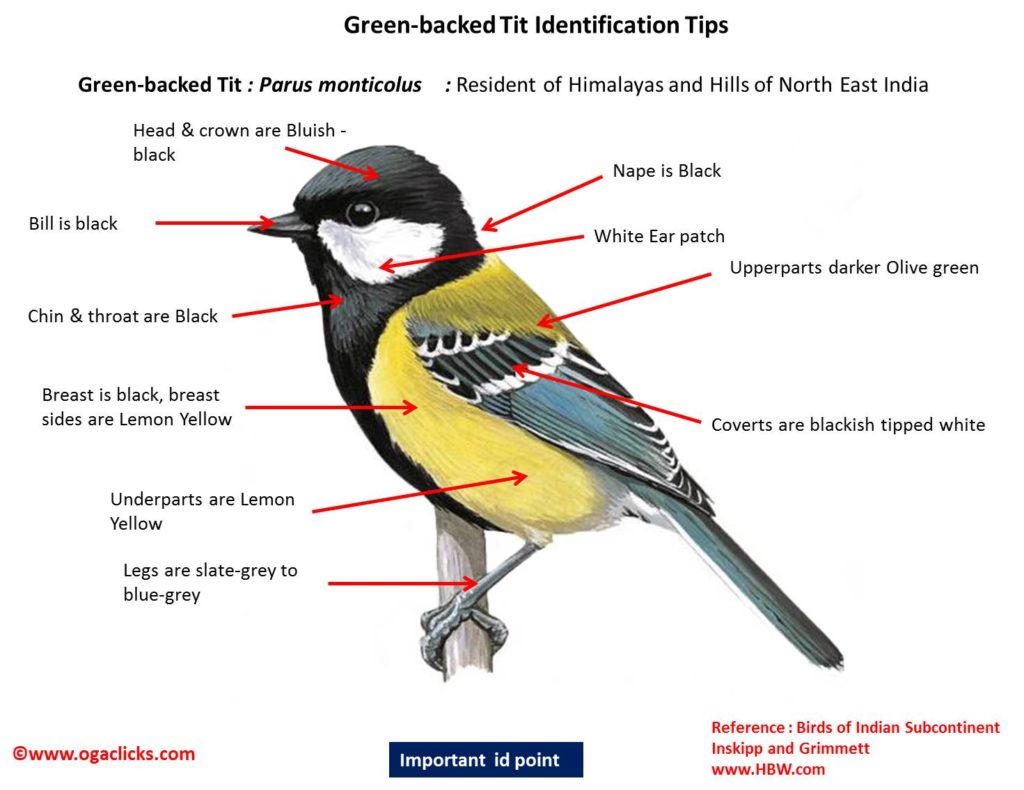Green-backed Tit

Green-backed Tit Parus monticolus
Etymology:
- Parus : Latin word for Tit
- Monticolus : Latin word mons-mountain; cola – inhabitant
Vernacular Names :Lepcha: Sarak-chak-pho, Cachar: Daosi-whet,Pahari: Chichinkothi
Distribution in India: Resident of Himalayas and North Eastern hills in India.
Description:
Size of 12·5–13 cm; wt. of 12–16·8 g. It is a large, black-capped tit with broad black ventral line, greenish upperparts and double wingbar. Themale of nominate race has a glossy bluish forehead to crown (to below eye) and nape, small whitish patch on center of lower nape. The upper edge of mantle is yellowish, bright olive-green on rest of mantle, scapulars and upper back, rump is light grey, uppertail-coverts are blackish. The tail is black, fringed dull violet-blue and all feathers are tipped white. The outermost rectrix with outer web is entirely white and broad white wedge at tip of inner web. The lesser upperwing-coverts are fringed pale grey, median coverts are blackish, finely fringed and tipped white, greaters are blackish, finely fringed bluish-grey and broadly tipped white, alula and primary coverts are black, finely fringed white, flight-feathers are sooty black, tertials are fringed and broadly tipped white, secondaries and inner primaries are finely fringed violet-blue. The cheek and ear-coverts to nape side are white. The chin, throat and side of neck to center of upper breast are black, slightly glossed blue on throat and breast. There are fairly broad but irregular black lines from lower bib to vent; rests of underparts are bright lemon-yellow. The flanks are washed olive, undertail-coverts are blackish, and broadly tipped white; axillaries and underwing-coverts are whitish. In worn plumage, crown and nape are duller, less glossy, wing and tail feathers are browner, and pale tips of greater coverts and fringes of tertials may be abraded or absent. The iris is light brown to dark brown; bill is black, paler cutting edges of lower mandible; legs are slate-grey to blue-grey. The female is like male, but has wing and tail browner, fringes of greater coverts, secondaries and primaries are duller or greyer, bib is duller,moresooty black, and ventral line narrower and less intensely black.
Habitat: It is found in temperate and subtropical forests, including deciduous forest, moist subtropical evergreen forest and higher-altitude birch and juniper and in undergrowth of bamboo and scrub. In non-breeding season it is found also in forest edge and more open areas of orchards, edges of cultivation and gardens. It breeds from2300 m up to 3650 m .In non-breeding season winters at 100m up to 3050 m.
Food habits: It eats small invertebrates and larvae, flower buds, small fruits, berries, and seeds. .It is found in pairs, but in post-breeding season more often in small family groups and in mixed-species foraging flocks with small babblers, warblers and flycatcher and Great Tit, It forages actively and acrobatically at all levels in forest trees and in undergrowth. It also searches trunk and branches of trees and in non-breeding season frequently on the ground. It is able to withstand deep snowfall and find food during periods of severe winter weather.
Breeding habits: They breed in Feb–Jul, Thenest is built solely by female. The nest is a soft pad of grass, plant fibers, moss, animal hair, wool and feathers, placed, in hole or cavity in tree trunk, old stump, or fence post, or in hole in rocks or earth bank. They lay a clutch of 4–8 eggs. The incubation is done by female and fed on nest by male. The chicks are fed by both parents.